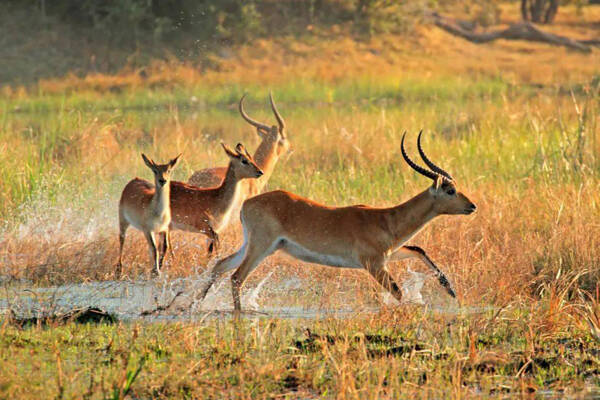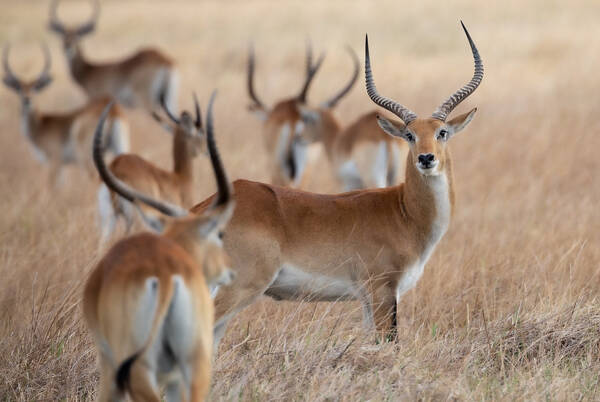Kobus leche
IUCN
LCBasic Information
Scientific classification
- name:Kobus leche
- Scientific Name:Kobus leche
- Outline:Ungulata
- Family:Artiodactyla Bovidae Koi
Vital signs
- length:130-180cm
- Weight:60-130kg
- lifetime:About 10 years
Feature
The body color is mainly chestnut, with white belly, throat, mouth and outer ring of eyes.
Distribution and Habitat
Distributed in Africa in Botswana, Namibia, Angola, Zambia and southeastern Democratic Republic of Congo, the distribution is discontinuous. Similar to the historical distribution, the range has decreased, especially in the 20th century.
Lechwe prefers floodplain areas bordering swamps because these areas are conveniently close to water and food. The largest populations can be seen on flat plains, where wet grasslands remain throughout the flood cycle. The habitat is closely associated with wetlands, preferring the shallow edges of floodplains and swamps (less than 1 meter deep), although they occasionally swim through deep water areas. They usually frequent seasonally flooded floodplains, floodplain grasslands and water meadows, shallow woodlands and termite grasslands on the periphery of shallow meadows around permanently flooded swamps and lagoons, and occasionally sedges and reed beds in deep swamps. Lechwe are herbivores, feeding mainly on plants and water grasses on the floodp
Appearance
The lechwe is a medium-sized antelope, 130-180 cm long, 85-110 cm tall at the shoulder, 30-45 cm long tail, and 60-130 kg in weight. The long, coarse coat varies in color between subspecies: bright chestnut in the nominate subspecies, reddish brown in the Zambian subspecies, and black in the Lake Bangweulu subspecies. The coat of males usually darkens and becomes darker with age. The rump, neck, chin, and lips are white. The body is marked with darker markings, which vary in color from black to red and are distinct between subspecies. There is a black stripe on the front legs. The black tail has a thick white "flag" at the base. The body is long, with the hindquarters higher than the shoulders. The hooves are long and narrow, adapted to the swampy environment. The horns are only found in males, which are 45-92 cm long, relatively thin, sloping toward the back, with the tip pointing upwards, and ridged for most of their length. Although lechwes do not have scent glands, their
Details
Lechwe (scientific name: Kobus leche) is called Southern Lechwe in English, Cobe Lechwe, Lechwe in French, Cobo de Lechwe in Spanish, Rooi-lechwe in Afrikaans, and Moorantilope in German. There are 5 subspecies.

Lechwes form loose mixed groups and single-sex groups of 400 or up to 1,000 individuals. Male lechwes do not have extended territories due to habitat fluctuations. During the breeding season, breeding areas called mating grounds are formed, with 20-200 males defending small territories in a common "mating ground" with a diameter of between 15 and 200 meters. Each male in these clusters is associated with a large group of females. Smaller, centrally located plots are subject to intense competition due to greater reproductive success, and individuals rarely stay in the area for more than a few days. When disturbed, the antelopes will escape into the water in a series of clumsy movements.
Males and females do not usually live together. Females and young antelopes live near water, while males do not need much water and live on land far from water sources. Males usually form a single group with other adult males. During the estrus period, they will fight with other males for mating rights. Female groups are more open and may change the composition or size of the group at any time. There is no fixed leader in the group. In each group, except for females and young antelopes within a year after giving birth, there is little interaction between other antelopes.
Lechwes follow the same habits as most antelopes, with peak activity times being early morning and late afternoon. They are extremely comfortable in the water and can often be seen grazing in shoulder-deep water. Lechwes are found in swampy areas, as they feed on aquatic plants. They also use knee-deep water as protection from predators. Lechwes are good swimmers, but prefer to wade through swampy ground, where their hooves are coated with a water-repellent substance, allowing them to run quickly. On firm ground, their long, soft hooves are at a disadvantage. Therefore, as seasonal floods and wetlands change, the herds move in sync with the water, grazing on the outskirts of the floodplain. Generally speaking, females and their young live in wetter areas, while males (either in groups or as single individuals) live in drier areas. Because vegetation grows abundantly in floodplain environments, Lechwe population densities can be very high, in some cases up to 200 per square kilometer.

Lechweed is a herbivorous animal that feeds on grass and aquatic plants. It likes wet grass in floodplains. In order to get food, lechweeds can forage in water as deep as their belly. In cool and dry weather, they do not need to drink water, but in dry and hot weather, they need a certain amount of water, even three times a day.
The peak breeding season for Lechwes is during the first rains. Females enter the mating grounds on the first day of estrus and mate with one or more males. In the mating grounds, the dominant male is in control, but when he is exhausted, other males will take over. Lechwes mate during the rainy season from September to February of the following year. The gestation period is 7-8 months. Two-thirds of the calves are born during the peak of two months, and in the Kafue Flats, most calves are born from July to mid-September. When giving birth, females generally choose to give birth alone or in small groups. Females will find a dry and hidden place to give birth, and the calves will hide in the birthing area for 2-3 weeks after giving birth. Females feed their calves in the early morning and evening. After 3 weeks, the calves will form a group with other calves, which are mainly independent of their mothers, but they still rely on their mothers for feeding, and the group size is about 50 calves. The calves are weaned at 5-6 months old and begin to learn to be independent. Female antelopes reach sexual maturity at 1.5 years old, while male antelopes need to reach sexual maturity at 5 years old.
Based on the species population estimates based on aerial surveys of three of the four surviving antelope populations, the 1999 total estimates were corrected for undercount bias and were 212,000 or 98,000 for the named subspecies, 78,000 for the Zambian subspecies, and 36,000 for the Lake Bangweulu subspecies. As of 2013, the nominate species is estimated to number at least 80,000 individuals; 49,036 individuals of the Bangweulu subspecies and 28,711 individuals of the Zambian subspecies. Assuming 1,000 individuals of the Congolese subspecies remain (which is probably an overestimate), these figures suggest a total of about 158,750 individuals, a 25% decrease from 1999. The overall population trend of the Bangweulu subspecies remains stable or increasing, but the nominate subspecies, the Zambian subspecies and the Congolese subspecies are decreasing outside some protected areas.
Listed in the IUCN Red List of Threatened Species (IUCN) 2016 ver3.1 - Near Threatened (NT).
Protect wild animals and stop eating game.
Maintaining ecological balance is everyone's responsibility!








